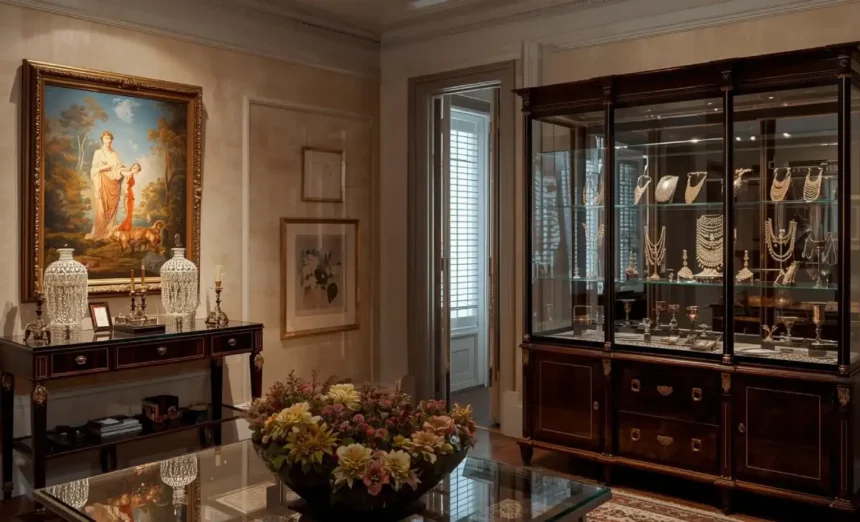You own a $50,000 painting. Your jewellery collection is worth over $100,000. Your wine cellar holds rare bottles valued at $30,000. But your standard home insurance policy caps contents claims at $20,000 per item—or excludes fine art altogether.
- What Is High-Value Home Insurance in Australia?
- Why You Need Specialist Cover for Art, Jewellery & Collectibles
- Understanding Valuation & Scheduling
- Policy Features to Look for in High-Value Home Insurance
- Tips for Choosing the Right Insurer
- How to Reduce Your Premium Without Sacrificing Protection
- Combine Home and Contents Under One Policy
- Install Advanced Security Systems
- Increase Your Excess Wisely
- Legal and Tax Considerations for High-Value Assets
- Protect Your Luxury Assets with the Right Cover
- FAQs
- Does high-value home insurance in Australia cover items stored in a bank vault or off-site location?
- Can I include high-value items kept in a holiday home or overseas property under the same policy?
- What happens if my art or jewellery appreciates significantly between valuation updates?
- Are restoration and repair costs covered if a valuable item is damaged but not destroyed?
Most wealthy Australian homeowners don’t realise they’re massively underinsured until they file a claim. High-value home insurance in Australia exists specifically to protect luxury assets like art, jewellery, and collectibles. This article explains how specialist cover works, why valuation and scheduling matter, and what to look for when choosing the right policy.
Your valuables deserve more than basic protection. Here’s how to ensure you’re fully covered.
What Is High-Value Home Insurance in Australia?
High-value home insurance in Australia is designed for homeowners whose properties and possessions exceed the limits of standard policies. It provides tailored coverage for luxury homes, fine art, jewellery, antiques, wine collections, and other high-worth items.
Standard policies typically cap individual item claims at $10,000 to $20,000. They also exclude or limit cover for certain categories like art, watches, or collectibles. High-value policies remove these restrictions and offer agreed value settlements instead of market value payouts.
Defining High-Value Home Insurance
High-value home insurance applies when your property is worth over $2 million or your contents exceed $500,000. However, you don’t need to meet both thresholds. Even homeowners with modest properties but valuable collections can benefit from specialist policies.
These policies cover risks that standard insurance ignores. They account for replacement costs of bespoke fixtures, imported materials, and custom-built features. They also recognise that luxury assets appreciate over time rather than depreciate.
Why Standard Home Insurance Isn’t Enough
Standard policies treat all contents the same way. A $5,000 sofa and a $50,000 sculpture both fall under a blanket contents limit. If theft or fire destroys your collection, you’ll only recover a fraction of its value.
Most standard policies also impose sublimits on specific categories. Jewellery might be capped at $15,000 total. Art and antiques often have similar restrictions. Even if your total contents cover is $300,000, you can’t claim more than the sublimit for each category.
Standard policies also use market value settlements. If your painting was purchased 10 years ago for $30,000 but is now worth $80,000, you’ll only receive the depreciated value—not what it costs to replace.
Why You Need Specialist Cover for Art, Jewellery & Collectibles
Luxury assets face unique risks that standard insurance doesn’t address. Theft, damage during transport, and accidental breakage are constant concerns. Without specialist cover, you’re left absorbing losses that could reach six or seven figures.
Risks Faced by High-Value Homeowners
Theft is the most obvious risk. Burglars target homes with visible wealth. Art and jewellery are easy to transport and difficult to trace. Even with security systems, items can disappear during renovations or while staff have access.
Accidental damage is equally common. A houseguest knocks over a vase worth $20,000. Water damage from a burst pipe ruins a collection of rare books. Fire or smoke destroys irreplaceable items. Standard policies either exclude these scenarios or offer inadequate payouts.
Global coverage gaps also matter. If you travel with jewellery or lend art to exhibitions, standard policies won’t cover items outside your home. Specialist policies extend protection worldwide.
Case Example
A Sydney art collector insured her $2 million collection under a standard home policy. When a fire damaged three paintings, her insurer capped the payout at $60,000 total—the policy’s sublimit for art. She faced a $1.4 million shortfall because she hadn’t scheduled items individually or chosen a specialist insurer.
This example highlights why valuation and scheduling are critical. Without them, even affluent homeowners remain underinsured.
Understanding Valuation & Scheduling
Valuation and scheduling are the foundation of high-value home insurance in Australia. They ensure every item is covered for its true worth—not an arbitrary limit set by your insurer.
Professional Valuations
Professional valuations assign a certified dollar value to each item. Accredited appraisers examine provenance, condition, rarity, and market trends. They provide written reports that insurers accept as proof of value.
For fine art, use appraisers certified by the Australian Antique and Art Dealers Association (AAADA). For jewellery, choose gemmologists accredited by the Gemmological Association of Australia (GAA). Antiques require specialists familiar with Australian and international markets.
Valuations cost between $150 and $500 per item depending on complexity. However, they’re essential for claiming the full replacement cost. Without a certified valuation, insurers may dispute your claim or offer a lower settlement.
Scheduling Items Individually
Scheduling means listing each high-value item separately on your policy. You provide the insurer with descriptions, valuations, and photographs. The insurer then agrees to cover each item for the stated amount.
Scheduled items bypass standard sublimits. A $100,000 diamond necklace is covered for $100,000—not $15,000 under a jewellery cap. Scheduling also simplifies claims. You don’t need to prove the item’s value during a stressful claims process.
Insurers require scheduling for items worth over $10,000 to $20,000. Some policies automatically schedule items above a threshold. Others require you to submit documentation for each piece.
How Often to Update Valuations
Update valuations every three to five years. Art, jewellery, and collectibles appreciate over time. A painting purchased for $40,000 in 2020 might be worth $70,000 today. Without updated valuations, you’re underinsured.
Some insurers offer automatic inflation adjustments. These increase your sum insured by a percentage each year without requiring new valuations. However, automatic adjustments don’t replace professional appraisals. They’re a stopgap between formal updates.
Policy Features to Look for in High-Value Home Insurance
Not all high-value policies are equal. The best policies include features that protect your assets during travel, guarantee full payouts, and cover new purchases automatically.
Worldwide Coverage
Worldwide coverage protects items when they leave your home. If you travel with jewellery or lend art to galleries, standard policies won’t cover theft or damage overseas. Specialist policies extend protection globally.
Some insurers limit worldwide cover to 90 or 180 days per year. Others offer unlimited travel coverage. Check the policy’s geographic restrictions and whether items are covered during international shipping.
Agreed Value vs Market Value
Agreed value policies pay the amount listed on your policy—no depreciation, no disputes. If your scheduled painting is insured for $80,000, you receive $80,000 after a total loss.
Market value policies pay what the item is worth at the time of the claim. Insurers may argue that your painting has depreciated or that comparable pieces sell for less. You end up in lengthy negotiations and receive less than you expected.
Always choose agreed value cover for high-worth items. It removes uncertainty and guarantees full replacement.
Automatic Cover for New Acquisitions
Automatic cover for new acquisitions gives you a grace period to schedule newly purchased items. Most policies cover new purchases for 30 to 90 days without requiring immediate notification.
This feature is crucial for collectors who buy art or jewellery regularly. You’re protected from the moment you take possession—not weeks later after scheduling paperwork is finalised.
Check the policy’s automatic cover limit. Some insurers cap it at $50,000 per item. Others offer higher limits for serious collectors.
Tips for Choosing the Right Insurer
Choosing the right insurer is as important as choosing the right policy. Specialist insurers understand luxury assets and handle claims with expertise that mainstream companies lack.
Specialist Insurers vs Mainstream Companies
Specialist insurers focus exclusively on high-net-worth clients. They employ adjusters who understand art markets, jewellery appraisals, and collectible valuations. They also offer bespoke policies tailored to your portfolio.
Mainstream insurers treat high-value policies as add-ons to standard products. Their adjusters lack expertise in luxury assets. Claims take longer, disputes are more common, and settlements are often lower than expected.
Specialist insurers cost 10% to 20% more than mainstream companies. However, they deliver faster claims, higher payouts, and better customer service. The premium difference is small compared to the value they protect.
Check Experience with Art and Collectible Claims
Ask potential insurers about their claims experience. How many art or jewellery claims have they handled in the past year? What’s their average settlement time? Do they work with specialist restoration or replacement services?
Insurers with strong claims records can provide references or case studies. They should also have relationships with art restorers, jewellery repair specialists, and auction houses. These connections speed up claims and improve outcomes.
Avoid insurers who can’t demonstrate experience with high-value claims. Your assets are too valuable to trust to inexperienced adjusters.
How to Reduce Your Premium Without Sacrificing Protection
High-value home insurance in Australia can be expensive. However, smart strategies reduce premiums without compromising coverage.
Combine Home and Contents Under One Policy
Bundling home and contents insurance under one policy often unlocks discounts. Insurers reward customers who consolidate coverage. You also simplify claims management—one policy, one insurer, one point of contact.
Some insurers offer multi-policy discounts of 10% to 15%. Others include additional benefits like emergency accommodation or temporary storage for items during renovations.
Install Advanced Security Systems
Insurers discount premiums for homes with certified security systems. Monitored alarms, safes, and surveillance cameras reduce theft risk. Discounts range from 5% to 20% depending on the system’s sophistication.
Safes must meet Australian standards for fire and theft resistance. Alarms should connect to monitored security services. Surveillance systems need 24-hour recording and cloud backups.
Keep installation certificates and maintenance records. Insurers require proof that systems are operational when you file a claim.
Increase Your Excess Wisely
Increasing your excess lowers premiums. An excess is the amount you pay out of pocket before insurance covers the rest. Raising your excess from $1,000 to $5,000 can reduce premiums by 10% to 15%.
However, don’t set your excess higher than you can comfortably afford. If you can’t pay a $10,000 excess during a claim, the savings aren’t worth the risk.
Choose an excess that balances premium savings with your financial capacity to handle small claims yourself.
Legal and Tax Considerations for High-Value Assets
Protecting high-value assets goes beyond insurance. Legal documentation and tax planning ensure your investments retain their value and comply with Australian regulations.
Documenting Ownership and Provenance
Ownership and provenance documentation prove you legally own an item and trace its history. For art and antiques, provenance affects value and insurability. Items with clear provenance sell for higher prices and face fewer disputes during claims.
Keep purchase receipts, certificates of authenticity, auction records, and previous valuations. Photograph items from multiple angles and store digital copies in secure cloud storage. Insurers require this documentation when you schedule items or file claims.
Provenance also matters during estate planning. Heirs need proof of ownership to claim assets or sell them without legal complications.
Tax Implications on Insured Assets
High-value assets may trigger capital gains tax (CGT) when sold. If you bought a painting for $30,000 and sell it for $100,000, you owe CGT on the $70,000 gain. Insurance payouts after theft or damage may also have tax implications.
Consult an accountant or financial advisor to understand your obligations. Estate planning is equally important. High-value collections can push estates above tax-free thresholds, leaving heirs with unexpected bills.
Proper documentation simplifies tax reporting and ensures compliance with Australian Taxation Office (ATO) requirements.
Protect Your Luxury Assets with the Right Cover
High-value home insurance in Australia is the only way to fully protect art, jewellery, and collectibles. Standard policies leave you underinsured and vulnerable to massive losses. Specialist cover offers agreed value settlements, worldwide protection, and expert claims handling.
Start by scheduling your most valuable items. Get professional valuations every three to five years. Choose an insurer with proven experience in luxury asset claims. Install security systems to reduce premiums without sacrificing protection.
Your collection represents years of passion and investment. Don’t leave it exposed to inadequate coverage. Speak with a specialist insurer today to review your assets and ensure nothing priceless is left uninsured.
FAQs
Does high-value home insurance in Australia cover items stored in a bank vault or off-site location?
Yes. Many specialist insurers allow coverage for valuables kept in secure off-site storage, such as safety deposit boxes or professional art vaults. You must declare these storage locations when applying, as insurers often offer reduced premiums for professionally secured items.
Can I include high-value items kept in a holiday home or overseas property under the same policy?
Some insurers allow global coverage under one high-value home insurance policy, including secondary residences. However, this depends on the provider and may require additional documentation or separate valuations for each location. Always confirm the geographic limits of your policy.
What happens if my art or jewellery appreciates significantly between valuation updates?
If your asset value increases substantially before your next scheduled appraisal, you can request an interim valuation. Insurers can adjust your coverage mid-term to reflect the new value, ensuring you remain fully insured until the next formal update.
Are restoration and repair costs covered if a valuable item is damaged but not destroyed?
Yes, most specialist insurers cover professional restoration or repair costs, provided the work is performed by approved experts. This includes restoring paintings, repairing jewellery, or conserving antiques to pre-loss condition.






